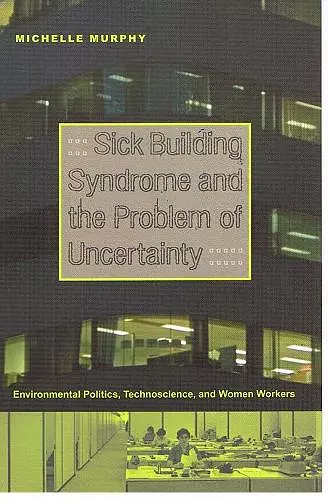Sick Building Syndrome and the Problem of Uncertainty
Environmental Politics, Technoscience, and Women Workers
Format:Paperback
Publisher:Duke University Press
Published:22nd Feb '06
Should be back in stock very soon

A detailed history of how sick building syndrome came into being: how indoor exposures to chemicals wafting from synthetic carpet, solvents, and so on became something that office workers felt and protested against
Before 1980, sick building syndrome did not exist. By the 1990s, it was among the most commonly investigated occupational health problems in the United States. Afflicted by headaches, rashes, and immune system disorders, office workers—mostly women—protested that their workplaces were filled with toxic hazards; yet federal investigators could detect no chemical cause. This richly detailed history tells the story of how sick building syndrome came into being: how indoor exposures to chemicals wafting from synthetic carpet, ink, adhesive, solvents, and so on became something that relatively privileged Americans worried over, felt, and ultimately sought to do something about. As M. Murphy shows, sick building syndrome provides a window into how environmental politics moved indoors.
Sick building syndrome embodied a politics of uncertainty that continues to characterize contemporary American environmental debates. Murphy explores the production of uncertainty by juxtaposing multiple histories, each of which explains how an expert or lay tradition made chemical exposures perceptible or imperceptible, existent or nonexistent. They show how uncertainty emerged from a complex confluence of feminist activism, office worker protests, ventilation engineering, toxicology, popular epidemiology, corporate science, and ecology. In an illuminating case study, she reflects on EPA scientists’ efforts to have their headquarters recognized as a sick building. Murphy brings all of these histories together in what is not only a thorough account of an environmental health problem but also a much deeper exploration of the relationship between history, materiality, and uncertainty.
“Sick Building Syndrome and the Problem of Uncertainty is all at once about the women’s health movement, ventilation, cybernetics, virology, and chemical toxicity. It is labor history and medical history wrapped into a fiercely disputed knot. Unraveling that tangle, and using the Syndrome to tell us about who we were at the turn of the millennium, M. Murphy has written a remarkable, insightful book.”—Peter Galison, author of Einstein’s Clocks, Poincaré’s Maps: Empires of Time
“How does an illness come into being? In this provocative study, M. Murphy takes us on a journey into the making of an environmental illness, into the spaces of the modern office building, gendered labor practices, and workers’ bodies to reveal what is perceived and what is invisible in the built environment where many Americans spend their working days. How sick buildings and indoor air pollution became visible problems in environmental health is a story that takes us far beyond the architectural history of office buildings. It takes us deep into the architecture of reality: into how we know and what we know about environmental exposures and the uncertainties they pose both to knowledge and human health.”—Gregg Mitman, author of The State of Nature: Ecology, Community, and American Social Thought, 1900–1950
ISBN: 9780822336716
Dimensions: unknown
Weight: 408g
264 pages